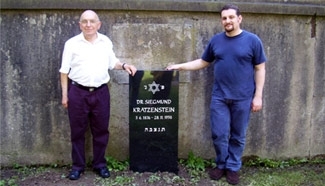PRAGUE, Sept. 13 (JTA) — A little more than a year ago, a retired gardener in Germany thought he had terminal cancer. Lying in his hospital bed at 5 a.m., Josef Speckmann switched on the television. Rachel Dohme, president of the German Jewish community of Hameln, was telling viewers that nobody knew where Siegmund Kratzenstein, the town’s most prominent Jewish citizen before World War II, was buried. Thanks to Speckmann, a stone was set last week on Kratzenstein’s grave — more than 70 years after his death — with the whole town marking the event. Speckmann, who survived his medical ordeal, was there to see the fruits of his courage. The lost and found grave highlights the quiet heroism of some during the Nazi era and shows the ongoing importance of recognizing the pain of the past. Kratzenstein, a doctor, was the last president of the Jewish community before Dohme. He was beloved by the town’s non-Jewish citizens for his kindness and the free medical services he provided to the poor, especially children, according to numerous testimonies. Speckmann, once a gardener’s apprentice in Hameln, helped the Jewish community bury Kratzenstein in the Jewish cemetery on a cold and rainy night in November 1938, after the doctor died of Nazi-inflicted injuries in Buchenwald. The Nazis dragged Kratzenstein to watch his synagogue burn down on Kristallnacht, then tortured him for several weeks at the camp. Speckmann had kept the burial secret for decades: His gravedigging could have cost him his life during Hitler’s reign of terror. Kratzenstein’s son had escaped to Australia, never to return to Germany, and those who participated in the burial were long gone. The grave was never marked and the community’s roughly 200 members were murdered by the Nazis or had fled. The Pittsburgh-born Dohme began revitalizing Hameln’s Jewish community in the 1990s. Hundreds of Russian Jews were coming to the area because of Germany’s immigration policy, which aimed to fortify Jewish life in the country. Part of Dohme’s efforts were directed at educating Germans and non-Germans about the contributions of Hameln’s prewar Jewish inhabitants. Eventually the mayor, teachers and even schoolchildren became immersed in reclaiming the town’s Jewish history. It was with great public fanfare earlier this month that Kratzenstein’s grandson-in-law, Harold Brown, and his great-grandson, David, came from Australia to finally set the gravestone and help recover the memory of a man who embodied the best of Germany’s prewar humanist traditions. “The newspaper headlines are calling him a saint,” Speckmann said. “I knew him, and he really was such a good man.” Across the ocean in Australia, Eva Brown and her brother Peter, now in their 60s, for years didn’t know anything about their grandfather, Hameln’s famous doctor. Eva’s husband Harold, 73, had spent decades doing genealogical research on his own Jewish family. But when he hit a dead end, he started to explore his wife’s roots. Thanks to Dohme’s Web site about the Hameln Jewish community, Brown was able to make the link to Kratzenstein. “He basically became my grandfather,” Brown said. “That’s how important he was to me.” While Brown was gathering information from various German state archives, Speckmann and Dohme began a correspondence over several months that culminated with an emotional meeting in the cemetery where the former Hameln resident pointed out Kratzenstein’s grave. “It turned out that Speckmann, without knowing it, had buried the good doctor in the place reserved for the Jewish community’s most important members,” Dohme said. Eva and Peter Brown decided to pay for a gravestone, but for health reasons were unable to travel to the stone-setting ceremony. They hope to visit the gravesite this year. Instead, Harold Brown was accompanied by Kratzenstein’s great-grandson David, 41, who is also a doctor. “The members of other churches apologized to me although they were born after the war; they apologized that their churches didn’t stand by Dr. Kratzenstein,” Harold Brown said. Realizing that something terrible was coming, Kratzenstein could have escaped from Germany before 1938, Dohme explained. But when he was elected president of the community, “he felt an obligation to all the Jews who could not leave, so he stayed and sealed his fate,” she said. Bernd Gelderblom, a German historian who has written a book about the Jews of Hameln, said that when Kratzenstein was brought to Buchenwald, the townspeople held several protests in front of Nazi headquarters demanding his release. “Protests of this kind were extremely rare. Can you imagine how much Kratzenstein must have meant to the town if people were willing to do this for him?” Gelderblom said. Then there is Speckmann, a shy 83-year-old, who at age 16 was urged by his boss to “be a mensch” and dig the grave during the night, even though a Nazi military building overlooked the graveyard. “You might think this is nothing, what Speckmann did, but I interviewed a non-Jewish man who made burial boxes for Jews in 1938, and the Nazis burned his house down,” Gelderblom said. “I am not a hero. I am a nobody,” Speckmann insisted. But when German media asked David Brown what he felt on the day of the stone-setting for his great-grandfather, he looked straight into Speckmann’s eyes and said, “I am so proud that Hameln was willing to break the law to bury him.”
German Jewish burial spot uncovered

Australians Harold Brown, left, and his son David stand near the newly set tombstone for their relative Siegmund Kratzenstein. (Courtesy of Rachel Dohme)
Advertisement





